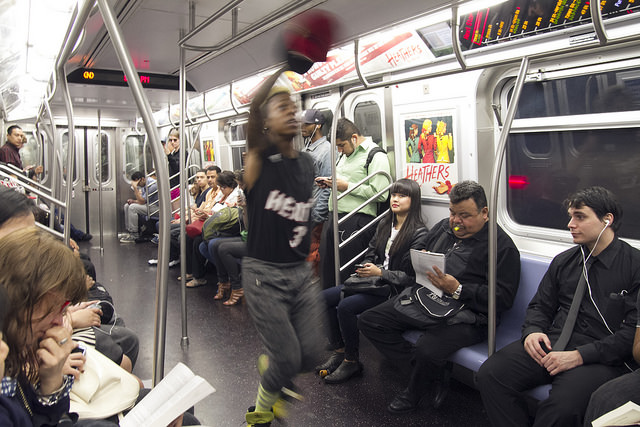My first run-in with subway performers was about two week ago. I had just moved to New York City from California and was already past the bewilderment-and-awe phase of catching a train across the Manhattan Bridge—I had moved onto the trying-not-to-fall-over phase. Among me, an elderly couple, a few businessmen, and a group of very tired tourists, there was not an ounce of I Heart New York spirit. Then, Canal Street. Enter, a group of young guys in sweatpants and baseball caps. They could have been going to the gym, save for the giant boombox one of their (presumably) girlfriends was lugging patiently behind them. As the doors closed, the tallest and most handsome of the four sauntered to the center of the train, where he began a speech I can only assume he had made about thirty times that day.
“Good afternoon! We are not just dancers,” he said, “We are entertainers.” He tried to give fist bumps to the passengers who weren’t interested.
“This is not just a way for us to earn money but also a way for us to stay out of trouble. If you like what you see, please support us with a donation. Every dollar counts!” On cue, the girlfriend started the music, bass-heavy and instrumental, and yet barely audible over the train. They took turns, all four of them, dancing in the center of the car—twisting around, dropping their hats then kicking them back onto their own heads, winding around the poles, and flipping themselves on the bars. They applauded one another. This, I thought, looking around at the unimpressed passengers, is a budget Circus du Soleil. I was wedged against one of the doors, trying my best to avoid getting kicked in the face during my seventh ever subway ride.
I had heard a little bit about the crackdown on dancers, or “hitters”, before I moved to NYC—something like 240 arrests so far in 2014. On one hand, it makes sense. It is physically unnerving at times, the anticipation of a possible sneaker to the face and general feeling that you are sitting on someone else’s stage. But when we buy that Metro ticket, we surrender ourselves to all sorts of violations of our personal space in the name of getting from here to there. Given that B-boying or breakdancing has been happening in New York City Subways since the ‘70s, it seems surprising that the MTA would decide that now is the time to start arresting people for it.
But that’s one of the nuances of this thing. Technically, they’re not being arrested for dancing. They’re being arrested for “aggressive soliciting” (a misdemeanor). And even though the MTA allows for performance, it does so within the definition of what it deems safe and non-obstructive—two things that dancing and swinging around on a train are not.
In any case, how does the MTA patrol a crime that runs every 10 minutes or so, in any given direction, in any given car? Of course, you can scout out the regular spots, become a break-dancer plainclothes cop, if you will. There’s Canal Street, Dekalb, your Upper Manhattan stations. That’s a lot of legwork though, and chasing acrobats from train to train like modern Tom and Jerries doesn’t do much for the image of the police department. NYPD Police Commissioner Bill Bratton has some novel ideas, including giving out permits or creating performance zones. They’ve already done it with musicians, so why not do the same with dancers?
But simply arresting hitters is a simplistic, extreme solution, considering most of the hitters are young folks who often claim that dancing is how they keep themselves out of the kind of trouble that would get them arrested in the first place.
The thing is, even if the MTA or NYPD were to arrest every subway break-dancer, or even “legitimize” them with a permit or safe-zone, it wouldn’t begin to touch on the one major factor that keeps performers riding from platform to platform. It is not that artists need to be recognized or considered legal, or even that they need to get paid. Sure, permits would make life easier in that performers wouldn’t be arrested or ticketed and, of course, everyone needs to get paid. But like other arts born out of a dense urban cradle—graffiti, hip-hop—subway dancers thrive because they cannot be harnessed or dictated.
A professional venue is a perk and the art is, as one hitter told me, “a tradition.” Survival despite confines is the New York City folklore of which they are descendants and purveyors. Commissioner Bratton cannot hope to stop them, not because there aren’t enough police willing to arrest them or jail cells big enough to hold them, but because the hitter’s movement and history is as vast as the 842 miles of subway system that run above and below New York City. Whether or not this reality makes a difference to Commissioner Bratton is of little importance. Lawful or not, the show will go on.









